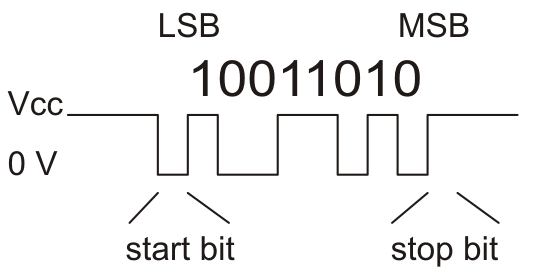Support » Qik 2s15v9 User’s Guide » 4. Serial Interface »
4.a. TTL and RS-232 Serial
The Qik requires a logic-level (0 to 3.3-5 V, or “TTL”), non-inverted serial input connected to its serial receive line, RX, or an RS-232 (inverted, ±3-15 V) serial input connected to its SIN pin. The serial interface is asynchronous, meaning that the sender and receiver each independently time the serial bits; asynchronous serial is available in computer serial ports (typically RS-232) and as hardware modules called “UARTs” on many microcontrollers (typically TTL). Asynchronous serial output can also be “bit-banged” by a standard digital output line under software control.
The data format is 8 data bits, one stop bit, with no parity, which is often expressed as 8-N-1. The diagram below depicts a typical asynchronous, non-inverted TTL serial byte:
 |
Diagram of a non-inverted TTL serial byte. |
|---|
A non-inverted TTL serial line has a default (non-active) state of high. A transmitted byte begins with a single low “start bit”, followed by the bits of the byte, least-significant bit (LSB) first. Logical ones are transmitted as high (Vcc) and logical zeros are transmitted as low (0 V), which is why this format is referred to as “non-inverted” serial. The byte is terminated by a “stop bit”, which is the line going high for at least one bit time. Because each byte also requires start and stop bits, each byte takes 10 bit times to transmit, so the fastest possible data rate in bytes per second is the baud rate divided by ten. At the maximum baud rate of 115,200 bits per second, the maximum realizable data rate, with a start bit coming immediately after the preceding byte’s stop bit, is 11,520 bytes per second.
The voltage on the RX pin should not go below 0 V and should not exceed 5 V. The Qik can accept a 3.3 V serial input on this line, so you can send commands to the Qik with a microcontroller running at 3.3 V. The Qik provides logic-level (0 – 5 V) serial output on its serial transmit line, TX, in response to commands that request information. Information requests result in the transmission of a single byte per request. If you aren’t interested in receiving feedback from the Qik, you can leave this line disconnected.
Note: Only the SIN line is compatible with RS-232 serial, which is inverted and uses voltages that would be out of spec (e.g. -15 to 15 V). You should not connect RS-232 serial lines to RX or TX. The Qik does not provide RS-232 serial output.



